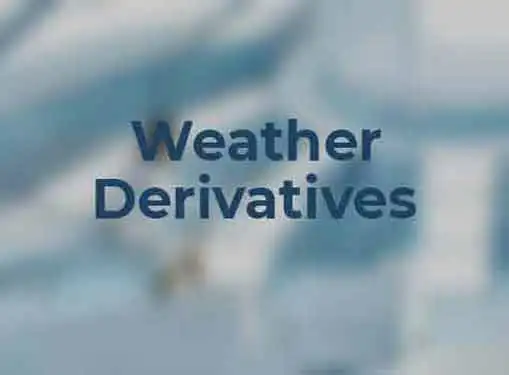Understanding Derivatives
Weather Derivatives
Written by Bennet Grill for Gaebler Ventures
Derivatives are a type of financial instrument whose value is derived (hence the name of the security) on some sort of underlying asset or value. Derivatives can be used to hedge against an existing investment or be used to function as a form of insurance. This article focuses on weather derivatives.
Weather derivatives can trace their origin to a power contract created in the summer of 1996 by Aquila Energy.

The company sold power to Consolidated Edison Company with the agreement that if the temperature was less than expected during the period of the contract, (thus requiring a lesser use of air conditioning and smaller overall power consumption) Aquila Energy would pay Consolidated Edison Co. a rebate.
Soon such weather related contracts were traded and within a couple of years, an $8 billion a year industry emerged.
Weather derivatives are essentially a bet on the performance of weather.
Power and energy companies, vacation spots, and resorts often make use of weather derivatives as a sort of insurance policy against weather performance which would negatively affect business. It is important to note, however, that weather derivatives are a completely separate from weather insurance. Insurance companies often sell weather insurance in case of a natural disaster, such as a flood, fire, tornado, or hurricane--premiums are paid to protect a certain piece of land or property. Weather derivates are contracts which pay a certain amount based on the performance of the weather.
There are a number of different metrics used in weather derivatives. Two of the most common measurements used in weather derivative contracts are Cooling Degree Days (CDDs) and Heating Degree Days (HDDs), which are contracts based strictly on temperature.
A Cooling Degree Day measures the number of degrees the average temperature is above 65º Fahrenheit--usually temperatures above this value require air conditioning-- hence the name Cooling Degree Day. A Heating Degree Day is the exact opposite of a CDD in that is measure the number of degrees the average temperature is below 65º Fahrenheit, where heating is more likely to be used.
It is estimated that approximately 98% of weather derivative contracts are temperature based, but there are also a number of other options available for those looking to trade weather based securities. Weather derivative contracts can be based on average number of frost days, snowfall levels, or even hurricanes.
Weather derivatives are traded as future contract-- after the energy market was deregulated in 1996, energy companies saw a huge opportunity to level out losses through the use of weather derivatives--essentially betting on the future temperature.
Enron, through its EnronOnline product, was actually the largest initial trader of weather derivatives. After Enron's collapse, weather derivatives remained a popular financial instrument and are currently traded on the Chicago Mercantile Exchange. You can find more information on the weather related contracts offered through this exchange on http://www.cme.com.
Bennet Grill is a writer who has a passion for business and finance. He is currently an Economics major at Duke University in North Carolina.
Share this article
Additional Resources for Entrepreneurs

Conversation Board
We welcome your feedback and questions regarding weather derivatives.